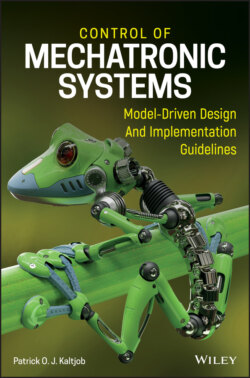Читать книгу Control of Mechatronic Systems - Patrick O. J. Kaltjob - Страница 16
Example 1.1
ОглавлениеFigure 1.1 shows a typical 3D printing robot for customized cooking with speed- and temperature-controlled system which could be combined with monitoring indicators for cooking time and cooking stage, as well as a control panel allowing the selection of the final mixing of the product and cooking program. This system would require:
1 the angular position control of a pressure valve delivering semi-liquefied food (paste), the x-y axis position control of the carriage driving the extruder head (nozzle) made of two motors with a screw mechanism, the table angular speed and the z-axis position control;
2 the heater temperature control (nozzle level);
3 the remote pressure and force control for the valve in charge of injecting pressured food paste feed based on environmental (e.g. space mission) and biological conditions (e.g. lower gravity forces); and
4 the logic control for the discrete selection of ingredients.
Figure 1.1 Customized 3D food printer.
Such control design combination enhances the product or machine functionality while reducing operating and maintenance costs. This is done by integrating data processing and computing operations within a field device or machine (e.g. washing machine, navigation systems etc.). Among the commonly encountered automated machines or products are those with: (i) embedded control functions; (ii) dedicated control functions; or (iii) a control function limited to a couple of sensors and actuators involved.
A technical process is the sum of all interacting machines within that process transforming and/or storing material, energy, or information. Such technical processes can be classified according to their operational objectives as follows:
1 Transportation-related processes, such as material handling processes, energy flow processes, and information transmission processes.
2 Transformation-related processes, such as chemical processes, manufacturing processes, power generation, and storage processes.
Technical processes can be characterized according to functional objectives, such as:
1 Processes characterized by a continuous flow of material or energy (e.g. cement drying process, electric power distribution, paper production). Here, the process variables are physically-related variables with a continuous range of values, such as temperatures in a heating system. The process parameters are physical properties (e.g. power transmission network impedance, liquefied gas density). Process control consists of maintaining the process state on a determined level or trajectory. In this case, process dynamics models can be obtained through differential equations.
2 Processes characterized by discrete event operations representing different process states such as device activation or deactivation during the startup or shutdown of a turbine. Here, process variables are binary signals indicating the discrete status of devices or machines involved in process operations as well as change in logic devices (e.g. activating events resulting from ON/OFF switch positioning). The process discrete event models can be obtained through Boolean functions or logic flow charts.
3 Processes characterized by identifiable objects that are transformed, transported or stored, such as silicon-based wafer production, data processing and storage operations. Here, process variables indicate the state changes of objects and can have a continuous range of values (i.e. temperature of a slab in a clogging mill, size of a part in a store) or binary variables. Those variables can also be non-physical categories (i.e. type, design, application, depot number) assigned to the objects.
